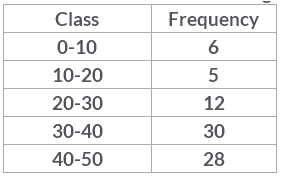Class 10 Exam > Class 10 Tests > Mathematics (Maths) Class 10 > Test: Mode of Grouped Data - Class 10 MCQ
Test: Mode of Grouped Data - Class 10 MCQ
Test Description
10 Questions MCQ Test Mathematics (Maths) Class 10 - Test: Mode of Grouped Data
Test: Mode of Grouped Data for Class 10 2025 is part of Mathematics (Maths) Class 10 preparation. The Test: Mode of Grouped Data questions and answers have been
prepared according to the Class 10 exam syllabus.The Test: Mode of Grouped Data MCQs are made for Class 10 2025 Exam. Find important
definitions, questions, notes, meanings, examples, exercises, MCQs and online tests for Test: Mode of Grouped Data below.
Solutions of Test: Mode of Grouped Data questions in English are available as part of our Mathematics (Maths) Class 10 for Class 10 & Test: Mode of Grouped Data solutions in
Hindi for Mathematics (Maths) Class 10 course. Download more important topics, notes, lectures and mock
test series for Class 10 Exam by signing up for free. Attempt Test: Mode of Grouped Data | 10 questions in 10 minutes | Mock test for Class 10 preparation | Free important questions MCQ to study Mathematics (Maths) Class 10 for Class 10 Exam | Download free PDF with solutions
Test: Mode of Grouped Data - Question 1
The modal class in the following frequency distribution is:

Detailed Solution for Test: Mode of Grouped Data - Question 1
Detailed Solution for Test: Mode of Grouped Data - Question 2
Detailed Solution for Test: Mode of Grouped Data - Question 4
Test: Mode of Grouped Data - Question 5
The age of 18 students of a class is reported below. Their modal age is 10, 17, 14, 10, 11, 12, 12, 13, 17, 13, 14, 14, 15, 16, 17, 15, 17, 16
Detailed Solution for Test: Mode of Grouped Data - Question 5
Test: Mode of Grouped Data - Question 6
The lower limit of the modal class of the following data is:
Detailed Solution for Test: Mode of Grouped Data - Question 6
Detailed Solution for Test: Mode of Grouped Data - Question 7
Detailed Solution for Test: Mode of Grouped Data - Question 8
Detailed Solution for Test: Mode of Grouped Data - Question 9
|
127 videos|665 docs|84 tests
|
Information about Test: Mode of Grouped Data Page
In this test you can find the Exam questions for Test: Mode of Grouped Data solved & explained in the simplest way possible.
Besides giving Questions and answers for Test: Mode of Grouped Data, EduRev gives you an ample number of Online tests for practice























